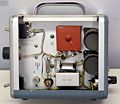108: Difference between revisions
No edit summary |
No edit summary |
||
| (2 intermediate revisions by one other user not shown) | |||
| Line 11: | Line 11: | ||
|designers= | |designers= | ||
|manuals= | |manuals= | ||
* [[Media:070-205.pdf|Tektronix 108 Manual]] | * [[Media:070-205.pdf|Tektronix 108 Manual]] | ||
}} | }} | ||
The '''Tektronix 108''' is a 1 ns rise-time pulse generator | The '''Tektronix 108''' is a 1 ns rise-time pulse generator | ||
| Line 19: | Line 19: | ||
It uses a [[mercury switch]] and [[selenium rectifiers]]. The output is through an [[N connector]]. | It uses a [[mercury switch]] and [[selenium rectifiers]]. The output is through an [[N connector]]. | ||
The price in July 1959 was $125. | The price in July 1959 was $125 ($1,300 in 2023 dollars). | ||
Referring to the output network photo below, current flows in from the left through the 1 kΩ resistor and charges the four red 0.1 μF capacitors in parallel. | Referring to the output network photo below, current flows in from the left through the 1 kΩ resistor and charges the four red 0.1 μF capacitors in parallel. | ||
When the mercury switch (terminals visible at lower right) closes, the capacitors are suddenly connected to the output load of the pulse generator, causing a sharp step in the output voltage. | When the mercury switch (terminals visible at lower right) closes, the capacitors are suddenly connected to the output load of the pulse generator, causing a sharp step in the output voltage. | ||
The starting voltage of the step is typically 0 V. The final voltage is adjustable, both in polarity and magnitude. The range is approximately −10 V to 10 V. | The starting voltage of the step is typically 0 V. The final voltage is adjustable, both in polarity and magnitude. The range is approximately −10 V to 10 V. | ||
In serial numbers 101 through 226, Type 108 units use [[selenium rectifiers]] in the power supply and a [[120-133]] power transformer. | |||
Starting with serial number 227, Type 108 units use silicon rectifiers in the power supply and a [[120-108]] power transformer. | |||
==Pictures== | ==Pictures== | ||
| Line 36: | Line 39: | ||
Tek type 108 late.jpeg| Late model 108 with silicon power rectifiers | Tek type 108 late.jpeg| Late model 108 with silicon power rectifiers | ||
</gallery> | </gallery> | ||
==Components== | |||
{{Parts|108}} | |||
[[Category:Pulse generators]] | [[Category:Pulse generators]] | ||
Latest revision as of 23:39, 22 October 2023
The Tektronix 108 is a 1 ns rise-time pulse generator intended for calibration of the 517. It is the predecessor of the more complex and faster 109.
Repetition rate of the 108 is 240 Hz and the maximum pulse amplitude is 10 Vp into a 50 Ω load. It uses a mercury switch and selenium rectifiers. The output is through an N connector.
The price in July 1959 was $125 ($1,300 in 2023 dollars).
Referring to the output network photo below, current flows in from the left through the 1 kΩ resistor and charges the four red 0.1 μF capacitors in parallel. When the mercury switch (terminals visible at lower right) closes, the capacitors are suddenly connected to the output load of the pulse generator, causing a sharp step in the output voltage. The starting voltage of the step is typically 0 V. The final voltage is adjustable, both in polarity and magnitude. The range is approximately −10 V to 10 V.
In serial numbers 101 through 226, Type 108 units use selenium rectifiers in the power supply and a 120-133 power transformer. Starting with serial number 227, Type 108 units use silicon rectifiers in the power supply and a 120-108 power transformer.
Pictures
-
Front view
-
Schematic
-
Left view, mercury switch
-
right view, selenium recitifier
-
Output network, rear of N connector
-
Page 190 in the 1959 Catalog
-
Mercury switch
-
Late model 108 with silicon power rectifiers
Components
Some Parts Used in the 108
| Part | Part Number(s) | Class | Description | Used in |
|---|---|---|---|---|
| 120-108 | 120-108 | Discrete component | power transformer | 108 |
| 120-133 | 120-133 | Discrete component | power transformer | 108 |








